Page 950 of 976
ENGINE
OVERHAUL55
CRANKSHAFT, CAMSHAFT, PISTONS AND
CYLINDER BLOCK
1.Remove timing belt rear cover.
2.Remove flywheel/drive plate housing.
3.Remove fuel lift pump.
4.Remove cylinder head.
5.Remove sump, oil pick-up and drain pipes.
6.Remove oil filter head.
7.Remove brake servo vacuum pump.Crankshaft rear oil seal - remove
1.Remove 5 bolts securing rear oil seal housing
to cylinder block.
2.Remove and discard oil seal and housing.
3.
Early engines:Remove and discard 'O' ring.
4.Remove and discard gasket.
Page 951 of 976
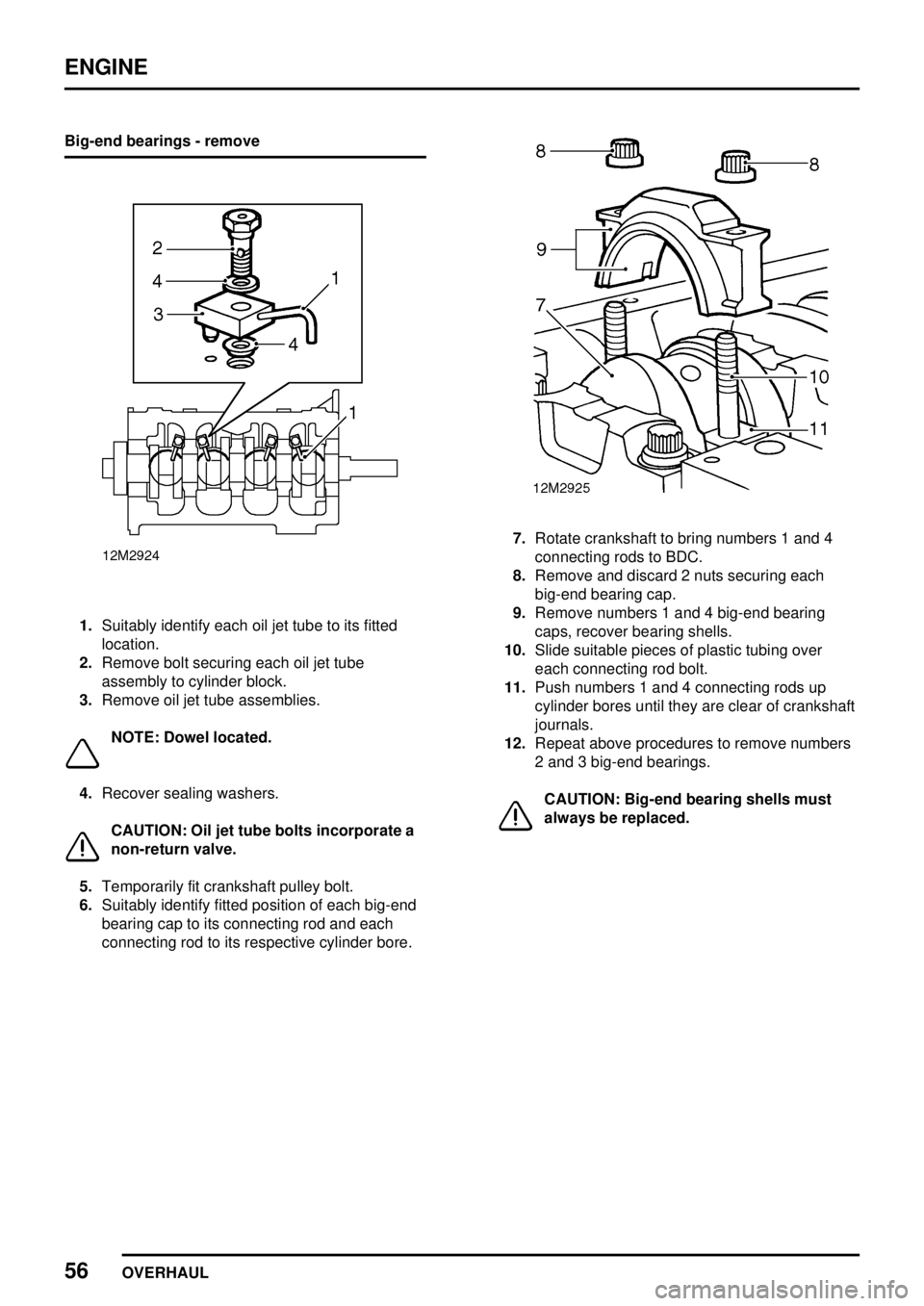
ENGINE
56
OVERHAUL Big-end bearings - remove
1.Suitably identify each oil jet tube to its fitted
location.
2.Remove bolt securing each oil jet tube
assembly to cylinder block.
3.Remove oil jet tube assemblies.
NOTE: Dowel located.
4.Recover sealing washers.
CAUTION: Oil jet tube bolts incorporate a
non-return valve.
5.Temporarily fit crankshaft pulley bolt.
6.Suitably identify fitted position of each big-end
bearing cap to its connecting rod and each
connecting rod to its respective cylinder bore.
7.Rotate crankshaft to bring numbers 1 and 4
connecting rods to BDC.
8.Remove and discard 2 nuts securing each
big-end bearing cap.
9.Remove numbers 1 and 4 big-end bearing
caps, recover bearing shells.
10.Slide suitable pieces of plastic tubing over
each connecting rod bolt.
11.Push numbers 1 and 4 connecting rods up
cylinder bores until they are clear of crankshaft
journals.
12.Repeat above procedures to remove numbers
2 and 3 big-end bearings.
CAUTION: Big-end bearing shells must
always be replaced.
Page 953 of 976
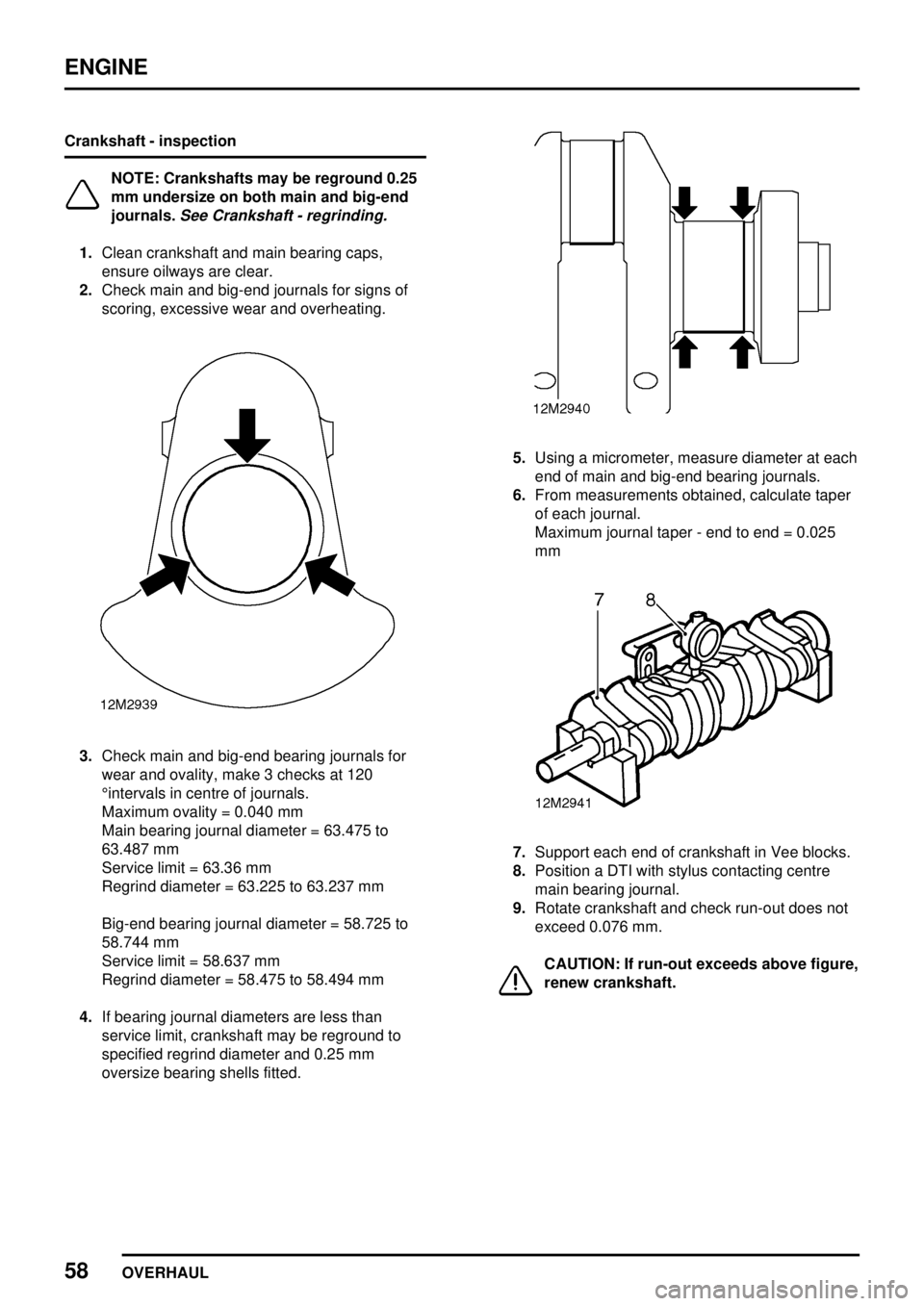
ENGINE
58
OVERHAUL Crankshaft - inspection
NOTE: Crankshafts may be reground 0.25
mm undersize on both main and big-end
journals.
See Crankshaft - regrinding.
1.Clean crankshaft and main bearing caps,
ensure oilways are clear.
2.Check main and big-end journals for signs of
scoring, excessive wear and overheating.
3.Check main and big-end bearing journals for
wear and ovality, make 3 checks at 120
°intervals in centre of journals.
Maximum ovality = 0.040 mm
Main bearing journal diameter = 63.475 to
63.487 mm
Service limit = 63.36 mm
Regrind diameter = 63.225 to 63.237 mm
Big-end bearing journal diameter = 58.725 to
58.744 mm
Service limit = 58.637 mm
Regrind diameter = 58.475 to 58.494 mm
4.If bearing journal diameters are less than
service limit, crankshaft may be reground to
specified regrind diameter and 0.25 mm
oversize bearing shells fitted.
5.Using a micrometer, measure diameter at each
end of main and big-end bearing journals.
6.From measurements obtained, calculate taper
of each journal.
Maximum journal taper - end to end = 0.025
mm
7.Support each end of crankshaft in Vee blocks.
8.Position a DTI with stylus contacting centre
main bearing journal.
9.Rotate crankshaft and check run-out does not
exceed 0.076 mm.
CAUTION: If run-out exceeds above figure,
renew crankshaft.
Page 954 of 976
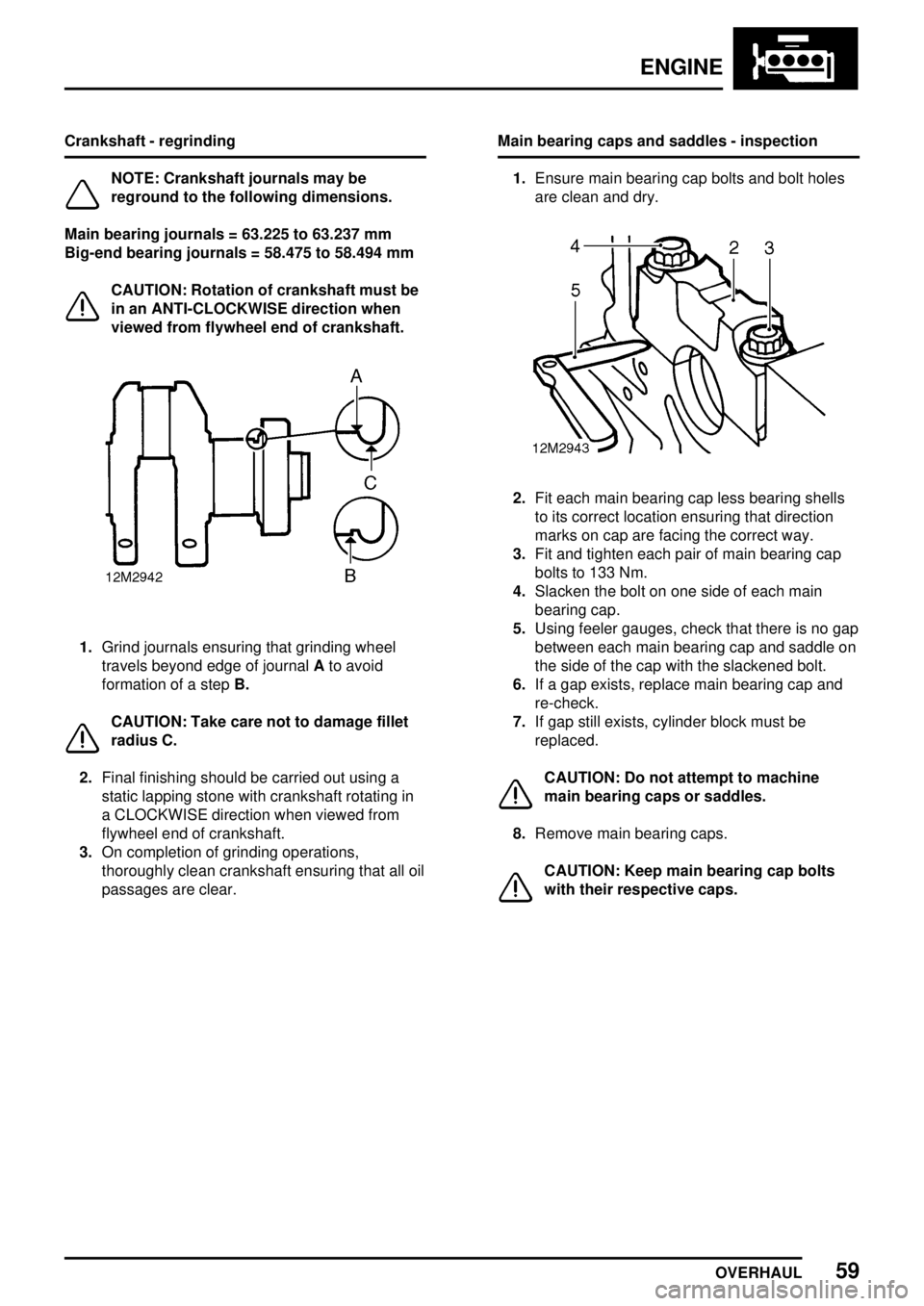
ENGINE
OVERHAUL59
Crankshaft - regrinding
NOTE: Crankshaft journals may be
reground to the following dimensions.
Main bearing journals = 63.225 to 63.237 mm
Big-end bearing journals = 58.475 to 58.494 mm
CAUTION: Rotation of crankshaft must be
in an ANTI-CLOCKWISE direction when
viewed from flywheel end of crankshaft.
1.Grind journals ensuring that grinding wheel
travels beyond edge of journalAto avoid
formation of a stepB.
CAUTION: Take care not to damage fillet
radius C.
2.Final finishing should be carried out using a
static lapping stone with crankshaft rotating in
a CLOCKWISE direction when viewed from
flywheel end of crankshaft.
3.On completion of grinding operations,
thoroughly clean crankshaft ensuring that all oil
passages are clear.Main bearing caps and saddles - inspection
1.Ensure main bearing cap bolts and bolt holes
are clean and dry.
2.Fit each main bearing cap less bearing shells
to its correct location ensuring that direction
marks on cap are facing the correct way.
3.Fit and tighten each pair of main bearing cap
bolts to 133 Nm.
4.Slacken the bolt on one side of each main
bearing cap.
5.Using feeler gauges, check that there is no gap
between each main bearing cap and saddle on
the side of the cap with the slackened bolt.
6.If a gap exists, replace main bearing cap and
re-check.
7.If gap still exists, cylinder block must be
replaced.
CAUTION: Do not attempt to machine
main bearing caps or saddles.
8.Remove main bearing caps.
CAUTION: Keep main bearing cap bolts
with their respective caps.
Page 956 of 976
ENGINE
OVERHAUL61
Crankshaft end-float - checking
1.Lubricate upper main bearing shells and
crankshaft main bearing journals with engine
oil.
2.Lubricate new standard size thrust washers
with engine oil and position washers in recess
in centre main bearing saddle.
NOTE: Grooved side of washers must face
outwards.
3.Using assistance, fit crankshaft.
4.Attach a DTI to rear face of cylinder block with
stylus contacting end of crankshaft; push
crankshaft fully rearwards and zero gauge.
5.Push crankshaft fully forwards and measure
end-float.
6.If end-float exceeds 0.05 to 0.15 mm, remove
crankshaft, fit combinations of standard and
oversize thrust washers to achieve correct
end-float.
CAUTION: Variations of thrust washer
thicknesses on each side of crankshaft
must not exceed 0.08 mm.
7.When end-float is correct, remove DTI.
8.Using assistance, remove crankshaft and
thrust washers. Ensure that thrust washers are
identified to their location.
Page 958 of 976
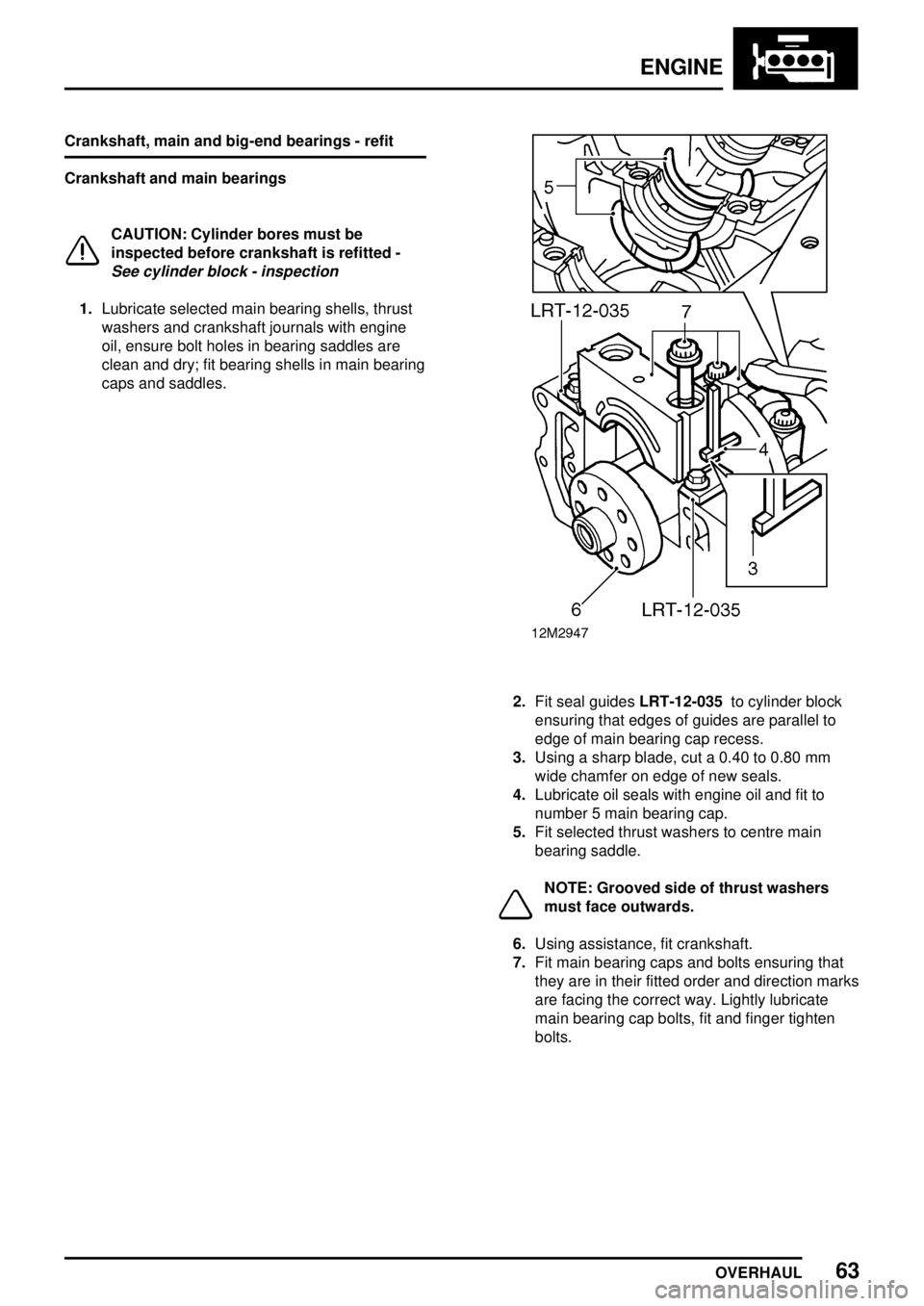
ENGINE
OVERHAUL63
Crankshaft, main and big-end bearings - refit
Crankshaft and main bearings
CAUTION: Cylinder bores must be
inspected before crankshaft is refitted -
See cylinder block - inspection
1.Lubricate selected main bearing shells, thrust
washers and crankshaft journals with engine
oil, ensure bolt holes in bearing saddles are
clean and dry; fit bearing shells in main bearing
caps and saddles.
2.Fit seal guidesLRT-12-035to cylinder block
ensuring that edges of guides are parallel to
edge of main bearing cap recess.
3.Using a sharp blade, cut a 0.40 to 0.80 mm
wide chamfer on edge of new seals.
4.Lubricate oil seals with engine oil and fit to
number 5 main bearing cap.
5.Fit selected thrust washers to centre main
bearing saddle.
NOTE: Grooved side of thrust washers
must face outwards.
6.Using assistance, fit crankshaft.
7.Fit main bearing caps and bolts ensuring that
they are in their fitted order and direction marks
are facing the correct way. Lightly lubricate
main bearing cap bolts, fit and finger tighten
bolts.
Page 960 of 976
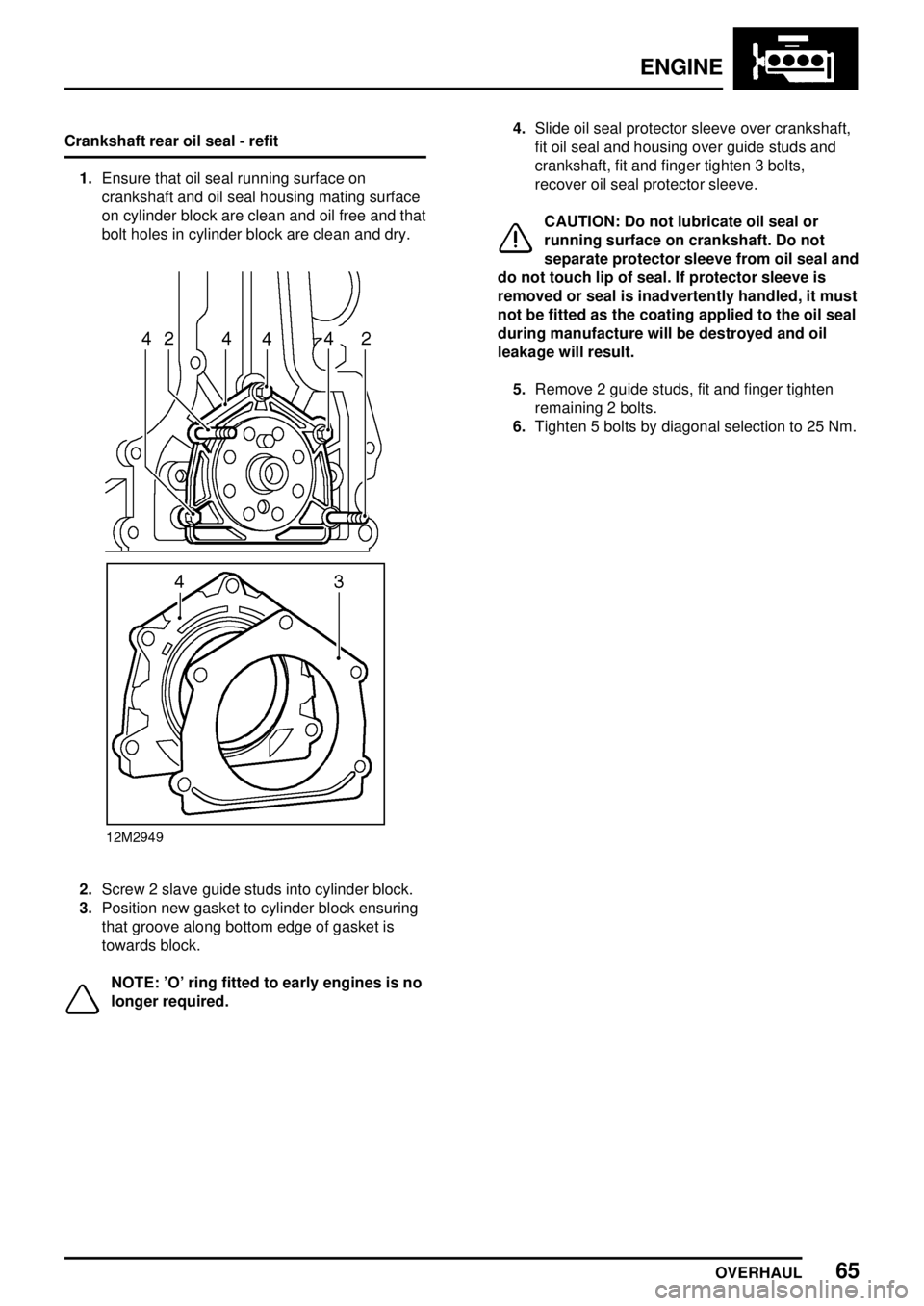
ENGINE
OVERHAUL65
Crankshaft rear oil seal - refit
1.Ensure that oil seal running surface on
crankshaft and oil seal housing mating surface
on cylinder block are clean and oil free and that
bolt holes in cylinder block are clean and dry.
2.Screw 2 slave guide studs into cylinder block.
3.Position new gasket to cylinder block ensuring
that groove along bottom edge of gasket is
towards block.
NOTE: 'O' ring fitted to early engines is no
longer required.4.Slide oil seal protector sleeve over crankshaft,
fit oil seal and housing over guide studs and
crankshaft, fit and finger tighten 3 bolts,
recover oil seal protector sleeve.
CAUTION: Do not lubricate oil seal or
running surface on crankshaft. Do not
separate protector sleeve from oil seal and
do not touch lip of seal. If protector sleeve is
removed or seal is inadvertently handled, it must
not be fitted as the coating applied to the oil seal
during manufacture will be destroyed and oil
leakage will result.
5.Remove 2 guide studs, fit and finger tighten
remaining 2 bolts.
6.Tighten 5 bolts by diagonal selection to 25 Nm.
Page 961 of 976
ENGINE
66
OVERHAUL Pistons and connecting rods - remove
1.Remove big-end bearings.
2.Suitably identify each piston to its respective
cylinder bore, check that arrow on piston crown
is pointing towards front of cylinder block; if
arrow is not visible, suitably mark piston.
3.Check that plastic tubing is fitted to connecting
rod bolts.
4.Push each piston and connecting rod up
cylinder bore until they can be withdrawn.
5.Remove big-end bearing shells from
connecting rods.
CAUTION: Big-end bearing shells should
always be renewed.
6.Inspect pistons and connecting rods.Piston rings - remove
1.Using a suitable expander, remove and discard
piston rings.
2.Using a squared-off end of an old piston ring,
remove carbon from piston ring grooves.